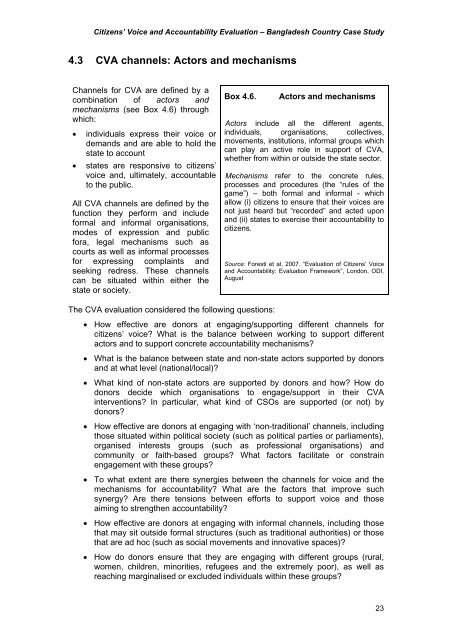Bangladesh - Belgium
Bangladesh - Belgium
Bangladesh - Belgium
You also want an ePaper? Increase the reach of your titles
YUMPU automatically turns print PDFs into web optimized ePapers that Google loves.
Citizens’ Voice and Accountability Evaluation – <strong>Bangladesh</strong> Country Case Study<br />
4.3 CVA channels: Actors and mechanisms<br />
Channels for CVA are defined by a<br />
combination of actors and<br />
mechanisms (see Box 4.6) through<br />
which:<br />
• individuals express their voice or<br />
demands and are able to hold the<br />
state to account<br />
• states are responsive to citizens’<br />
voice and, ultimately, accountable<br />
to the public.<br />
All CVA channels are defined by the<br />
function they perform and include<br />
formal and informal organisations,<br />
modes of expression and public<br />
fora, legal mechanisms such as<br />
courts as well as informal processes<br />
for expressing complaints and<br />
seeking redress. These channels<br />
can be situated within either the<br />
state or society.<br />
Box 4.6.<br />
Actors and mechanisms<br />
Actors include all the different agents,<br />
individuals, organisations, collectives,<br />
movements, institutions, informal groups which<br />
can play an active role in support of CVA,<br />
whether from within or outside the state sector.<br />
Mechanisms refer to the concrete rules,<br />
processes and procedures (the “rules of the<br />
game”) – both formal and informal - which<br />
allow (i) citizens to ensure that their voices are<br />
not just heard but “recorded” and acted upon<br />
and (ii) states to exercise their accountability to<br />
citizens.<br />
Source: Foresti et al, 2007. “Evaluation of Citizens’ Voice<br />
and Accountability: Evaluation Framework”, London, ODI,<br />
August<br />
The CVA evaluation considered the following questions:<br />
• How effective are donors at engaging/supporting different channels for<br />
citizens’ voice? What is the balance between working to support different<br />
actors and to support concrete accountability mechanisms?<br />
• What is the balance between state and non-state actors supported by donors<br />
and at what level (national/local)?<br />
• What kind of non-state actors are supported by donors and how? How do<br />
donors decide which organisations to engage/support in their CVA<br />
interventions? In particular, what kind of CSOs are supported (or not) by<br />
donors?<br />
• How effective are donors at engaging with ‘non-traditional’ channels, including<br />
those situated within political society (such as political parties or parliaments),<br />
organised interests groups (such as professional organisations) and<br />
community or faith-based groups? What factors facilitate or constrain<br />
engagement with these groups?<br />
• To what extent are there synergies between the channels for voice and the<br />
mechanisms for accountability? What are the factors that improve such<br />
synergy? Are there tensions between efforts to support voice and those<br />
aiming to strengthen accountability?<br />
• How effective are donors at engaging with informal channels, including those<br />
that may sit outside formal structures (such as traditional authorities) or those<br />
that are ad hoc (such as social movements and innovative spaces)?<br />
• How do donors ensure that they are engaging with different groups (rural,<br />
women, children, minorities, refugees and the extremely poor), as well as<br />
reaching marginalised or excluded individuals within these groups?<br />
23

















